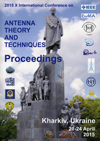State-of-the-art of the low frequency radio astronomy, relevant antenna systems and international cooperation in Ukraine
DOI:
https://doi.org/10.1109/ICATT.2015.7136772Keywords:
radio astronomy, radio interferometry, radio telescope, phased arraysAbstract
The low frequency radio astronomy (decameter-meter range, frequencies of 10-300 MHz) currently demonstrates rapid progress all over the world. New generations of large antennas - LOFAR, LWA, MWA and others - have been created in many countries. At the same time Ukrainian radio astronomical systems UTR-2 and URAN still remain the largest and most informative ones at the lowest frequency range available for the ground-based radio astronomy (below 33 MHz), especially after their radical modernization during the most recent years. A great number of top priority results have been obtained on the basis of these radio telescopes. The results prove a high significance of the low frequency radio astronomy for astrophysics. Substantial part of these results have been obtained in the course of many year cooperation between Ukraine on one side and France, Austria, Germany and other countries on the other. Creation of new low frequency instruments GURT (Ukraine) and LSS/NenuFAR (France) for the wide frequency range of 10-80 MHz opens up new possibilities for research and fruitful cooperation.References
BRAUDE, S.Y.; MEGN, A.V.; SODIN , L.G. Decameter wavelength radio telescope UTR-2, Antennas, 1978, v.26, p.3-15.
MEGN, A.V.; BRAUDE, S.Y.; RASHKOVSKIY, S.L. URAN system of the decametric interfero-meters, Radio Physics and Radio Astronomy, 1997, v.2, n.4, p.385-401.
BRAUDE, S.Y.; MEGN, A.V. Radio Astronomy Researches in Ukraine in Decameter Wave Range, Radio Physics and Radio Astronomy, 1996, v.1, n.1, p.9-24.
LECACHEUX, A.; KONOVALENKO, A.A.; RUCKER, H.O. Using large radio telescopes at decameter wavelength, Planet. Space Sci., 2004, v.52 , p.1357-1374, doi: http://dx.doi.org/10.1016/j.pss.2004.09.006.
KONOVALENKO, A.A. Low-Frequency Radio Astronomy Prospects, Radio Physics and Radio Astronomy, 2005, v.10, p.S86-S114.
ABRANIN, E.P.; BRUCK, Y.M.; ZAKHARENKO, V.V.; KONOVALENKO, A.A. The new preamplification system for UTR-2 radio telescope, Exp. Astron, 2001, v.11, pp.85-112, doi: http://dx.doi.org/10.1023/A:1011109128284.
KONOVALENKO, A.A. Ukraine decameter wave radio astronomy systems and their perspectives, Radio Astronomy at Long Wavelengths. American Geophysical Union, 2000, p.311-319, doi: http://dx.doi.org/10.1029/GM119p0311.
VAN HAARLEM, M.P.; WISE, M.W.; GUNST, A.V. LOFAR: the low-frequency array, Astron. & Astrophys., 2013, v.650, p.1-56, doi: http://dx.doi.org/10.1051/0004-6361/201220873.
TAYLOR, G.B.; ELLINGSON, S.W.; KASSIM, N.E. First light for the first station of the Long Wavelength Array, Journal of Astron. Instrum., 2012, n.1, p.1-29, doi: http://dx.doi.org/10.1142/S2251171712500043.
RYABOV, V.B.; VAVRIV, D.M.; ZARKA, P. A low-noise, high dynamic range digital receiver for radio astronomy applications: an efficient solution for observing radio-bursts from Jupiter, the Sun, pulsars and other astrophysical plasmas below 30 MHz, Astron. & Astrophys, 2010, v.510, p.16-28, doi: http://dx.doi.org/10.1051/0004-6361/200913335.
KONOVALENKO, A.A.; FALKOVICH, I.S.; RUCKER, H.O. New antennas and methods for the low frequency stellar and planetary radio astronomy, Planetary Radio Emission VII, 2010, p.521-532.
KONOVALENKO, A.A.; FALKOVICH, I.S.; KALINICHENKO, N.N. Thirty-elements active antenna array as a prototype of a huge low-frequency radio telescope, Exp. Astron, 2005, v.16, n.3, p.149-164, doi: http://dx.doi.org/10.1007/s10686-003-0030-8.
FALKOVICH, I.S.; KONOVALENKO A.A.; GRIDIN, A.A. Wide-band high linearity active dipole for low frequency radio astronomy, Exp. Astron, 2011, v.32, p.127-145, doi: http://dx.doi.org/10.1007/s10686-011-9256-z.
ZARKA, P.; GIRARD, J.; TAGGER, M.; DENIS, L. LSS/NenuFAR: The LOFAR Super Station project in Nancay, Proc. of the Annual Meeting of the French Society of Astron. and Astrophys, p.687-694.
ZAKHARENKO, V.V.; VASYLIEVA, I.Y.; KONOVALENKO, A.A. Detection of decameter-wavelength pulsed radio emission of 40 known pulsars, Mon. Not. Roy. Astron. Soc., 2013, v.431, p.3624-3641, doi: http://dx.doi.org/10.1093/mnras/stt470.
STEPKIN, S.V.; KONOVALENKO, A.A., KANTHARIA, N.G., SHANKAR, N. UDAYA. Radio recombination lines from the largest bound atoms in space, Mon. Not. Roy. Astron. Soc., 2007, v.374, p.852-856, doi: http://dx.doi.org/10.1111/j.1365-2966.2006.11190.x.
STANISLAVSKY, A.A.; KOVAL, A.A.; KONOVALENKO, A.A. Low-frequency heliographic of the quiet Sun corona, Astron. Nachr., 2013, v.334, n.10, p.1086-1092, doi: http://dx.doi.org/10.1002/asna.201211839.
KONOVALENKO, A.A.; KALINICHENKO, N.N.; RUCKER, H.O. Earliest recorded ground-based decameter wavelength observations of Saturn's lightning during the giant E-storm detected by Cassini spacecraft in early, Icarus, 2013, v.224, p.14-23, doi: http://dx.doi.org/10.1016/j.icarus.2012.07.024.
ZAKHARENKO, V.; MYLOSTNA, C.; KONOVALENKO, A. Ground-based and spacecraft observations of lightning activity on Saturn, Planet. Space Sci., 2012, v.61, p.53-59, doi: http://dx.doi.org/10.1016/j.pss.2011.07.021.
ZARKA, P.; FARRELL, W.; FISCHER, G.; KONOVALENKO, A. Ground-based and space-based radio observations of planetary lightning, Space Sci. Rev., 2008, v.137, p.257-269, doi: http://dx.doi.org/10.1007/s11214-008-9366-8.
KONOVALENKO, A.A.; STANISLAVSKY, A.A.; RUCKER, H.O. Synchronized, observations by using the STEREO and the largest ground based decameter radio telescope, Exp. Astron, 2013, v.36, p.137-154, doi: http://dx.doi.org/10.1007/s10686-012-9326-x.
ZARKA, P.; BOUGERET, J.-L.; BRIAND, C. Planetary and exoplanetary low frequency radio observations from the Moon, Planet. Space Sci., 2012, v.74, p.156-166, doi: http://dx.doi.org/10.1016/j.pss.2012.08.004.
LITVINENKO, G.V.; LECACHEUX, A.; KONOVALENKO, A.A. Modulation structures in the dynamic spectra of Jovian radio emission obtained with high time-frequency resolution, Astron. & Astrophys, 2009, v.493, p.651-660, doi: http://dx.doi.org/10.1051/0004-6361:200809676.
BRIAND, C.; ZASLAVSKY, A.; MAKSIMOVIC, M. Faint solar structures from decametric observations, Astron. & Astrophys, 2008, v.490, p.339-344, doi: http://dx.doi.org/10.1051/0004-6361:200809842.
MELNIK, V.N.; KONOVALENKO, A.A.; RUCKER, H.O. Observations of powerful Type III bursts in the frequency range 10-30 MHz, Solar Phys., 2011, v.269, n.2 p.335-350, doi: http://dx.doi.org/10.1007/s11207-010-9703-4.

